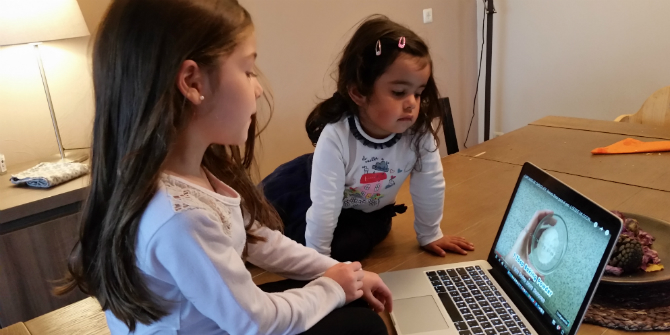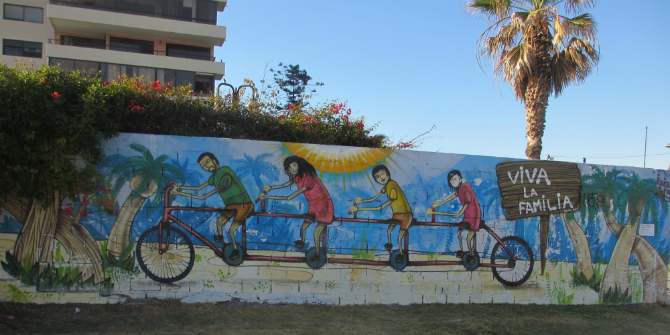 To mark the 30th anniversary of the UN Convention on the Rights of the Child, LSE Professor Sonia Livingstone, who has been part of the team drafting the UN Committee on the Rights of the Child’s General Comment on children’s rights in relation to the digital environment, reflects on the on-going need to address violations and abuses of child rights in the digital world.
To mark the 30th anniversary of the UN Convention on the Rights of the Child, LSE Professor Sonia Livingstone, who has been part of the team drafting the UN Committee on the Rights of the Child’s General Comment on children’s rights in relation to the digital environment, reflects on the on-going need to address violations and abuses of child rights in the digital world.
Last week was the 30th anniversary of the UN Convention on the Rights of the Child. A day to celebrate, as many are around the world. Since 1989 the Convention has promoted the importance of children’s rights within human rights debates and actions, and has promoted the importance of human rights in debates and actions concerned with child wellbeing.
But this is now a digital world, and it is timely to ask: how shall we implement children’s rights in relation to the digital environment? The digital environment facilitates the rapid spread and extensive networking of information and communication in ways that can be aggregated and analysed on a global scale, which can be both beneficial and harmful. Today, all our digital interactions generate data that can be shared, searched, altered or exploited by third parties, and the consequences may be exciting or unwanted, and are often unintended and unpredictable.
Many States prioritise digital innovation and deployment in their national economic development plans. The more that digital technology becomes embedded in children’s lives as part of the infrastructure of the societies in which they live, the more important is the digital environment for the realisation of the full range of children’s rights, including civil, political, economic, social and cultural rights, as well as the right to protection.
But evidence is piling up of the violation and abuse of children’s rights in a digital world, and many questions arise:
- How should we respect children’s rights to expression and assembly now that expression (by children but also by adults) is hugely amplified by dominant platforms?
- The right to protection faces real difficulties in dealing with the problems of online grooming, cyberbullying, the spread of race hate and easy access to extreme pornography, among others; but the scale of the problem is outpacing law enforcement. What can be done?
- The right to privacy, traditionally conceived mainly in relation to the child’s social circle or the State, faces new challenges now that it is the dominant business model of the internet to monetise our everyday lives under surveillance capitalism. Can this right be protected?
- How can parents be responsible for their children online as they are offline, when their child’s digital life – so visible to others, including companies – is so invisible and inaccessible to them?
- How can others provide a duty of care to children when they may have no way of knowing who is a child online?
The threat is both to individual children and to the very idea of childhood itself. Many of the activities we associate with childhood – playing, being naughty, taking risks, making new friends, keeping secrets, learning from mistakes, making a mess – take on a sinister dimension in a digital world designed for commercial and adult interests and, too rarely, one which serves children’s best interests.
Indeed, it is becoming an effort to remember society’s original hopes for children and the internet – a world of information at their fingertips, everyone connected, unlimited opportunities for expression, burgeoning creativity and exploration! Yet for children, this is what is most salient – they see the digital environment as their space, a way to exercise their rights, and while there’s a lot they want changed, they are full of hope for what it can offer.
The UN Committee on the Rights of the Child is responding by developing a General Comment on children’s rights in relation to the digital environment. As I have explained earlier, the plan is to produce guidance for States around the world, all of which have ratified the Convention (except, significantly, the USA). That this guidance is much needed is apparent from the 135 responses from all continents that were submitted to the public consultation held by the Committee to inform its work.
Different countries have different priorities, of course. In many parts of the world, access is crucial. Going beyond the provision of mere technology, UNICEF defines “meaningful access” as that which overcomes barriers of affordability, connectivity, literacy, discrimination and inclusivity so as to enable children to participate fully in a digital world. The gender gap persists worldwide, affecting girls as well as women, to the point where trying to gain access to a digital device, for instance in a cybercafé, can put girls at risk of sexual harassment and abuse.
Meanwhile it seems to be higher income countries which face some of the cutting edge challenges in relation to children’s rights and the internet, with considerable struggles over children’s rights regarding privacy, protection, freedom etc., and with algorithmic discrimination and data surveillance threatening children’s rights in a widening range of situations.
Particularly challenging for States is the degree to which commercial interests, and the technological design and architecture of digital services, shape the experiences of users (including children) in ways that fundamentally affect how they can exercise their rights online and, also, offline. As the UN has decreed, business enterprises and other stakeholders have particular responsibilities regarding human rights in a digital world – and this applies to children as well. But none of this makes effective implementation of the Convention easy, and small or poor States especially struggle to manage the impact of global corporate players within their jurisdiction.
Particularly challenging for child rights organisations is that it can be States themselves that violate children’s rights in the digital environment, for example through the use (or over-use) of digital surveillance technologies by law enforcement or in schools, or in failing to address the exclusion of marginalised children or those with disabilities from digital services enjoyed by their peers, or by preventing adolescents from accessing information about sexuality and health online (or offline), or through internet shutdowns which break family communication or deny children in extreme situations access to vital digital means of learning and support.
As part of the drafting team working on the General Comment, I found it heartening to read through the many responses to the public consultation. These offered a wealth of high quality, carefully evidenced contributions to thinking about children’s rights in a digital world. They recognised both children’s status as rights-holders but also their vulnerability. They referenced a wide range of rights, demonstrating the cross-cutting nature of the digital environment as it impacts on children’s lives.
Encouragingly, a common theme was the importance of maintaining a careful balance between online risks and opportunities, in order that an understandable concern with protection does not obscure or override children’s civil rights and freedoms. Even the submissions which were primarily focused on protecting children from harm were careful to recognise the benefits that the internet offers children. Children’s own voices and experiences also provide a valuable inspiration, and we will report soon on the global consultation held among children regarding their rights in the digital environment.
It is this balance between participation and protection, as well as the effort to uphold universal principles while recognising contextual diversity, which we will need to navigate as child rights researchers and advocates facing the challenges of a fast-changing digital environment.
This article represents the views of the author, and not the position of the Parenting for a Digital Future blog, nor of the London School of Economics and Political Science.
This post originally appeared on the Media@LSE blog and has been reposted here with permission.





